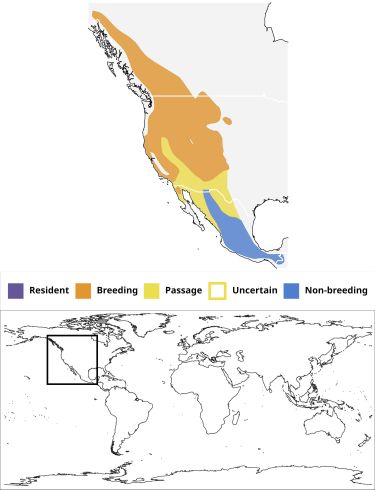m |
m (→Taxonomy) |
||
| (13 intermediate revisions by 6 users not shown) | |||
| Line 1: | Line 1: | ||
| − | [[Image:1061Dusky_FC_P70705143web.jpg|thumb|550px|right|Photo by Forcreeks | + | '''Alternative name: American Dusky Flycatcher'''<br /> |
| − | + | '''Disambiguation: For African Dusky Flycatcher (''Muscicapa adusta'') see [[African Dusky Flycatcher]]''' | |
| + | [[Image:1061Dusky_FC_P70705143web.jpg|thumb|550px|right|Photo by {{user|Forcreeks|Forcreeks}}<br />Cabin Lake, [[Oregon]], [[USA]], 07 July 2005]] | ||
;[[:Category:Empidonax|Empidonax]] oberholseri | ;[[:Category:Empidonax|Empidonax]] oberholseri | ||
==Identification== | ==Identification== | ||
| − | + | 13-15.2 cm, 9.3-11.4 g<br /> | |
| + | Back gray with slight olive tinge; breast buffy, with light throat; belly very pale yellow. Narrow white eye ring and white wing bars; long tail. | ||
| + | [[Image:DuskyFlycatcherIMG 7278.jpg|thumb|350px|right|Photo by {{user|jmorlan|Joseph Morlan}}<br />East Palo Alto, [[California]], [[USA]], 04 December 2020]] | ||
| + | ====Similar species==== | ||
| + | [[Hammond's Flycatcher]] differs most obviously in its longer primary projection, also slightly darker breast and smaller bill; although usually seen in tall conifers, on migration Hammond's can occur with Dusky in lower scrub. [[Gray Flycatcher]] has longer bill with dark tip. Gray dips tail down like a phoebe while Dusky pumps tail up. | ||
| + | |||
| + | Likely to overlap with [[Acadian Flycatcher]], [[Alder Flycatcher]], [[Buff-breasted Flycatcher]], [[Cordilleran Flycatcher]], [[Gray Flycatcher]], [[Hammond's Flycatcher]], [[Least Flycatcher]], [[Pacific-slope Flycatcher]], [[Pine Flycatcher]], [[White-throated Flycatcher]], [[Willow Flycatcher]], [[Yellow-bellied Flycatcher]], [[Yellowish Flycatcher]]. | ||
| + | |||
| + | See also [[Empidonax|<i>Empidonax</i>]]. | ||
| + | |||
==Distribution== | ==Distribution== | ||
| − | [[British Columbia]] | + | [[North America|North]] and [[Central America]]<br /> |
| + | Breeds western North America from central [[British Columbia]] south to [[California]], [[Arizona]] and [[New Mexico]]; winters to southern [[Mexico]]. | ||
| + | |||
| + | [[File:20230517_Empidonax_oberholseri.jpg|375px|thumb|right|Approximate distribution map. From Xeno canto / NatureServe data at file date (from Xeno Canto)]] | ||
==Taxonomy== | ==Taxonomy== | ||
| − | + | Formerly sometimes treated as a subspecies of [[Gray Flycatcher]] as ''E. wrightii oberholseri'', though the two are not particularly closely related within the genus [[#References|[2]]]. | |
| + | ====Subspecies==== | ||
| + | Clements regards this as a [[Dictionary_M-O#M|monotypic]] species [[#References|[1]]]. | ||
| + | |||
==Habitat== | ==Habitat== | ||
| − | Scrub, brushland, thickets, open coniferous forests, and mountain chaparral. | + | Scrub, brushland, thickets, open low coniferous forests, and mountain chaparral. Unlike [[Hammond's Flycatcher]], not in tall, dense conifers except at the edges of open areas or where where tree spacing is more open. |
| + | |||
==Behaviour== | ==Behaviour== | ||
| + | ====Diet==== | ||
The diet includes insects. | The diet includes insects. | ||
| − | + | ====Breeding==== | |
The nest is cupshaped. | The nest is cupshaped. | ||
==References== | ==References== | ||
| − | All About Birds | + | #{{Ref-Clements6thAug11}}#{{Ref-HBWVol9}}#Avibase |
| + | #All About Birds | ||
| + | {{ref}} | ||
==External Links== | ==External Links== | ||
| + | Search the Gallery using the scientific name: | ||
{{GSearch|Empidonax+oberholseri}} | {{GSearch|Empidonax+oberholseri}} | ||
| + | Search the Gallery using the common name: | ||
| + | {{GSearch|"Dusky Flycatcher"}} | ||
| + | {{GS-checked}} | ||
| + | <br /> | ||
| + | <br /> | ||
| + | |||
[[Category:Birds]] [[Category:Empidonax]] | [[Category:Birds]] [[Category:Empidonax]] | ||
Latest revision as of 15:58, 12 October 2023
Alternative name: American Dusky Flycatcher
Disambiguation: For African Dusky Flycatcher (Muscicapa adusta) see African Dusky Flycatcher
- Empidonax oberholseri
Identification
13-15.2 cm, 9.3-11.4 g
Back gray with slight olive tinge; breast buffy, with light throat; belly very pale yellow. Narrow white eye ring and white wing bars; long tail.
Similar species
Hammond's Flycatcher differs most obviously in its longer primary projection, also slightly darker breast and smaller bill; although usually seen in tall conifers, on migration Hammond's can occur with Dusky in lower scrub. Gray Flycatcher has longer bill with dark tip. Gray dips tail down like a phoebe while Dusky pumps tail up.
Likely to overlap with Acadian Flycatcher, Alder Flycatcher, Buff-breasted Flycatcher, Cordilleran Flycatcher, Gray Flycatcher, Hammond's Flycatcher, Least Flycatcher, Pacific-slope Flycatcher, Pine Flycatcher, White-throated Flycatcher, Willow Flycatcher, Yellow-bellied Flycatcher, Yellowish Flycatcher.
See also Empidonax.
Distribution
North and Central America
Breeds western North America from central British Columbia south to California, Arizona and New Mexico; winters to southern Mexico.
Taxonomy
Formerly sometimes treated as a subspecies of Gray Flycatcher as E. wrightii oberholseri, though the two are not particularly closely related within the genus [2].
Subspecies
Clements regards this as a monotypic species [1].
Habitat
Scrub, brushland, thickets, open low coniferous forests, and mountain chaparral. Unlike Hammond's Flycatcher, not in tall, dense conifers except at the edges of open areas or where where tree spacing is more open.
Behaviour
Diet
The diet includes insects.
Breeding
The nest is cupshaped.
References
- Clements, JF. 2011. The Clements Checklist of Birds of the World. 6th ed., with updates to August 2011. Ithaca: Cornell Univ. Press. ISBN 978-0801445019. Spreadsheet available at http://www.birds.cornell.edu/clementschecklist/downloadable-clements-checklist
- Del Hoyo, J, A Elliot, and D Christie, eds. 2004. Handbook of the Birds of the World. Volume 9: Cotingas to Pipits and Wagtails. Barcelona: Lynx Edicions. ISBN 978-8487334696
- Avibase
- All About Birds
Recommended Citation
- BirdForum Opus contributors. (2024) Dusky Flycatcher. In: BirdForum, the forum for wild birds and birding. Retrieved 21 May 2024 from https://www.birdforum.net/opus/Dusky_Flycatcher
External Links
Search the Gallery using the scientific name:
Search the Gallery using the common name:
GSearch checked for 2020 platform.






